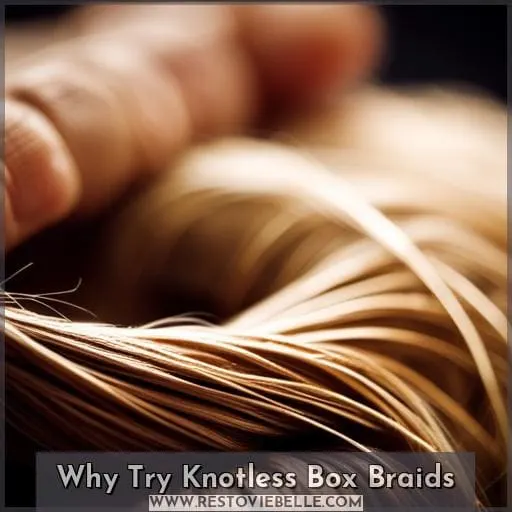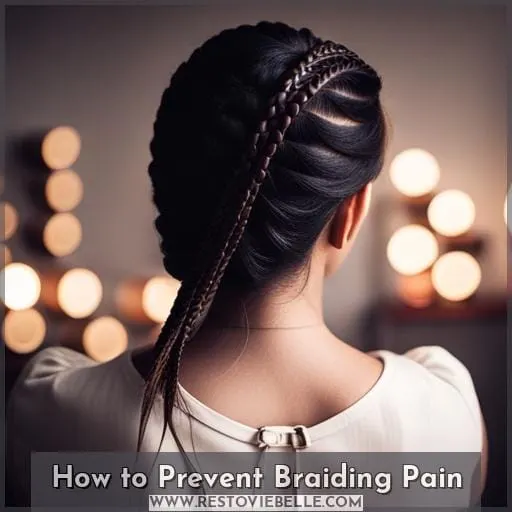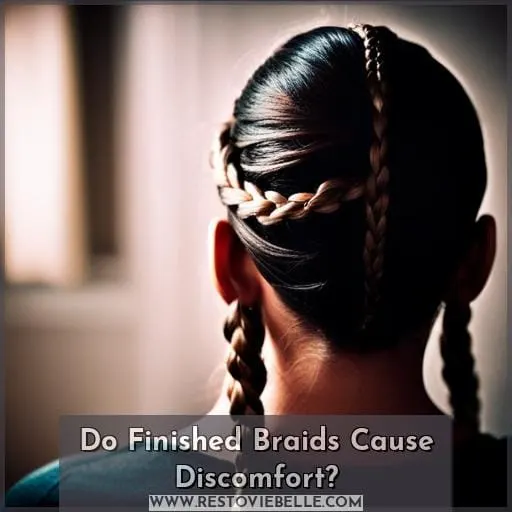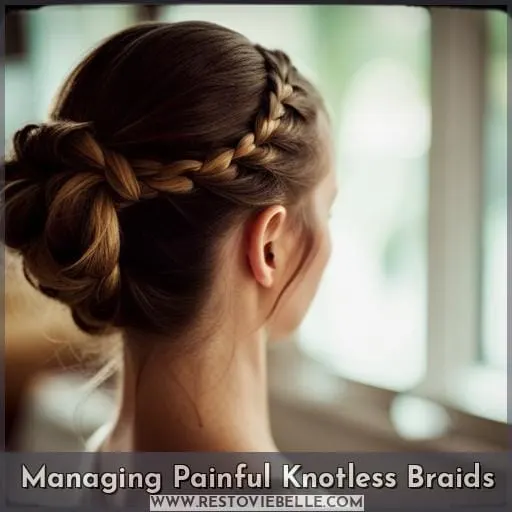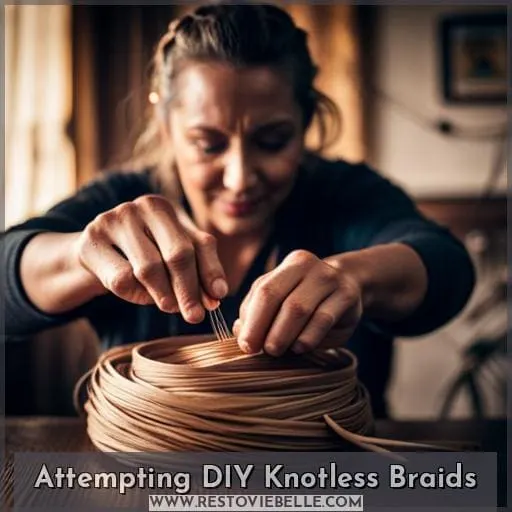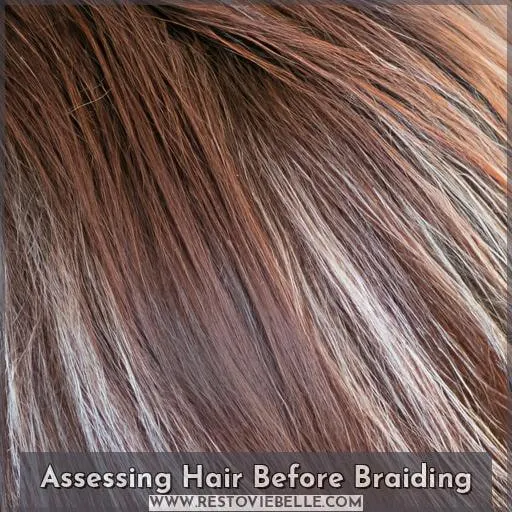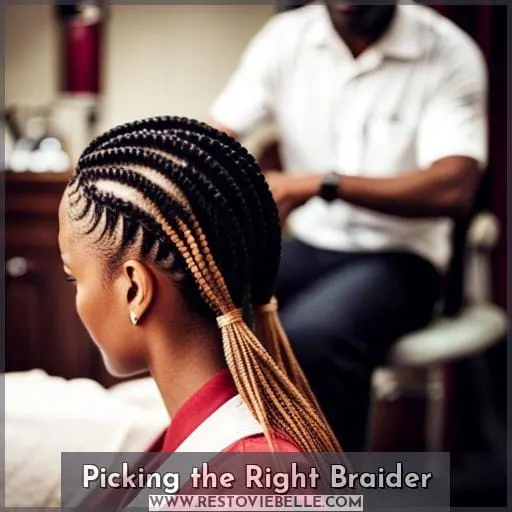This site is supported by our readers. We may earn a commission, at no cost to you, if you purchase through links.
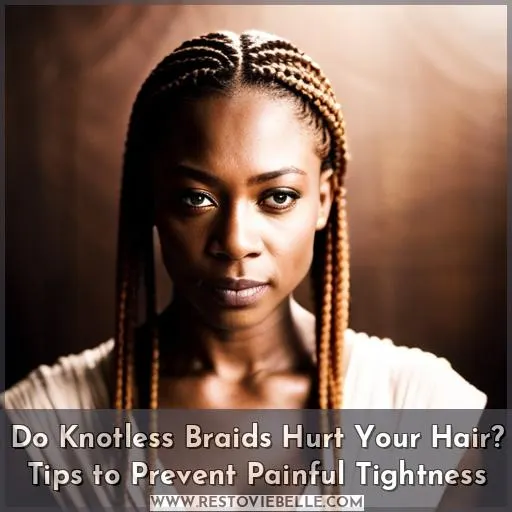 Curious if knotless braids hurt your hair? It’s time to uncover the truth. Knotless box braids have gained popularity for their pain-free reputation, but is that really the case?
Curious if knotless braids hurt your hair? It’s time to uncover the truth. Knotless box braids have gained popularity for their pain-free reputation, but is that really the case?
In this article, we’ll delve into whether or not knotless braids can cause discomfort and provide tips on preventing painful tightness. Discover how to maintain healthy hair while rocking this trendy protective style.
Table Of Contents
Key Takeaways
- Achieving a modern style without tight knots.
- Knotless braids offer versatile styling options and reflect cultural influence.
- Maintaining moisture balance and practicing gentle detangling techniques is essential.
- Evaluate comfort and make adjustments to relieve tension and discomfort.
Why Try Knotless Box Braids
You’re choosing knotless box braids for their modern look without the painful tight knots.
As celebrities like Tessa Thompson showcase knotless braids, their styling versatility and cultural influence inspire you to try this protective style.
The feed-in technique with extensions creates a familiar box braid look that aligns with cultural appreciation while prioritizing scalp health.
Knotless braids offer immediate styling options, from wearing hair up or down to changing parts, that support hair goals and a busy lifestyle.
Although professional installation is recommended for optimal results, with patience and practice, DIY knotless braiding can be an accessible alternative for nurturing your natural hair.
How to Prevent Braiding Pain
You can take steps before and during the braiding process to prevent excessive tightness and discomfort.
Properly washing, conditioning, and detangling your natural hair prior to braiding will minimize pain and build-up.
Being mindful not to pull too tightly while braiding can also reduce irritation to your scalp and roots.
Pre-Braiding Hair Care
So how can you properly prepare your hair before getting knotless braids to minimize discomfort during and after installation?
- Maintain moisture balance through regular deep conditioning treatments.
- Use a wide-tooth comb and leave-in conditioner to gently detangle hair.
- Promote scalp health with tea tree oil to reduce inflammation.
- Request braiders use minimal tension when installing the braids.
Mindful Braiding
To prevent braiding pain while getting knotless braids, be mindful of the tension and pulling during the braiding process.
- Request gentle braiding techniques that avoid excessive scalp tension, which causes discomfort.
- Speak up if a style is too tight.
- Proper detangling with conditioner minimizes knots and eases sectioning.
- Overall, communication ensures braiders understand your preference for pain-free braiding focused on long-term styling comfort.
Do Finished Braids Cause Discomfort?
Once your knotless braids are complete, you’ll want to assess any discomfort at the roots or from the length of the braids to know if remedies may be needed.
- Evaluate the scalp sensation and root tension to determine if it falls within comfortable limits or is too tight.
- Consider if the weight of the braids causes strain, influencing pain tolerance.
- Analyze if desired styling freedom is achievable based on individual preferences and pain thresholds.
Careful examination after the braiding process allows for prompt relief measures if painful tightness occurs. Factors like braid size, parting, and weight impact tension. Paying attention to discomfort levels can reveal if knotless braid characteristics align with expectations for a pain-free protective style.
Managing Painful Knotless Braids
If you experience discomfort or pain from your knotless braids, there are ways to manage and alleviate the discomfort.
Immediate relief measures can include:
- Spraying water or leave-in conditioner on the scalp for instant relief,
- Releasing tight styles to help reduce pain caused by over-direction.
If persistent pain occurs, repositioning the braids and moisturizing the scalp may provide relief.
It’s important to address any severe or prolonged pain with a professional stylist to prevent traction alopecia.
Immediate Relief Measures
Alleviation comes from spraying water or leave-in conditioner for immediate relief if you’re experiencing painful tightness from your knotless braids.
- Mist braids with moisture for cooling relief.
- Treat irritated areas by gently detangling and soothing the scalp.
- Implement quick fixes like releasing over-directional styles that create unnecessary tension.
Persistent Discomfort
If you experience persistent discomfort while wearing knotless braids, there are steps you can take to alleviate the pain.
- Pain Evaluation:
- Assess the severity and location of your discomfort to determine if further action is needed.
- Braiding Techniques:
- Opt for a looser tension during the braiding process to minimize tightness and pressure on your scalp.
- Scalp Health:
- Keep your scalp moisturized and healthy by applying oils or using soothing products specifically designed for protective styles.
- Styling Options:
- Explore different hairstyles that don’t put excessive strain on your hairline or roots.
By following these tips, you can manage painful tightness associated with knotless braids and enjoy a more comfortable experience without compromising style or health.
Attempting DIY Knotless Braids
Now that you understand how to manage and alleviate pain when it comes to knotless braids, let’s explore the world of attempting DIY knotless braids.
While professional hairstylists can enhance aesthetics, doing your own knotless box braids is a viable option. Thanks to the vast array of video tutorials available online, you can find guidance for successfully achieving this trendy hairstyle in the comfort of your own home.
However, it’s important to acknowledge that attempting DIY knotless braids does come with its challenges. It requires patience and careful execution of various braiding techniques. The size of your braid sections and the technique used in feeding in hair play crucial roles in achieving a polished look.
By taking on the challenge yourself, not only can you save money but also have more control over how gently or tightly each braid is styled.
Assessing Hair Before Braiding
Before braiding your hair, it’s crucial to assess its health and condition.
- Ensure hair is properly moisturized and not overly dry or brittle.
- Check for any signs of traction alopecia or damaged edges.
- Consider your natural hair type and if it’s suitable for braiding.
- Evaluate the overall pre-braiding condition focusing on factors like shedding, thinning, and breakage.
Having healthy, well-cared for hair is key for protecting strands during the braiding process. Undamaged and properly moisturized hair withstands manipulation better, reducing risk of breakage. Assessing hair beforehand prevents worsening any existing conditions like thinning edges.
This thoughtful preparation sets the stage for promoting healthy retention and growth once braids are installed.
Picking the Right Braider
You can ensure suffering less pain by choosing a braider who grasps the intricacies of natural hair.
Seek a stylist well-versed in protective styling for kinky textures, able to assess hair health and determine suitable braid sizes.
Favor braiders working privately, providing a clean and professional environment conducive to open communication.
Research potential braiders online through reviews, portfolios and client testimonials to gauge experience with knotless techniques.
Schedule a consultation, asking questions to determine compatibility regarding gentleness, listening skills and responsiveness.
An empathetic braider mindful of traction alopecia risks can guide you through size and parting selections for minimized tension.
Discuss growth goals to align on a low-manipulation protective style suiting your hair needs.
Frequently Asked Questions (FAQs)
How long do knotless braids usually last?
Knotless braids typically last 4-6 weeks.
With proper maintenance like washing every 2 weeks and moisturizing, you’ll maximize longevity while rocking a protective, low manipulation style.
What are some tips for removing knotless braids without damage?
Like detangling a delicate web, take care when removing knotless braids.
Work gently to loosen the roots then unravel down.
Use conditioner, detangling spray, seamless combs and wide tooth combs.
Handle your hair tenderly to prevent breakage.
What types of hair accessories work best with knotless braids?
Headbands, hair clips, and decorative combs blend effortlessly with knotless braids.
Weave in strands of beads or gold cuffs for an elegant finish.
Choose accessories that match your personal style without weighing down the braids.
How often should you wash knotless braids?
Wash your knotless braids every 2-3 weeks.
Use a gentle shampoo and thoroughly rinse.
Follow with a moisturizing conditioner, focusing on your scalp.
Gently pat braids dry with a towel.
Allow to air dry before styling to maintain neatness between washes.
What are signs that my knotless braids are too tight?
If your scalp feels constant tension or throbbing pain from your braids, this likely signals too much tightness.
Gently check for inflammation or tenderness along the hairline to assess fit.
Proper braiding shouldn’t cause lasting discomfort.
Conclusion
Ultimately, knotless braids can be a comfortable and pain-free option for styling your hair. By following proper pre-braiding care, being mindful during the braiding process, and managing any discomfort that may arise, you can enjoy the beauty of knotless box braids without sacrificing your comfort.
Whether you choose to visit a professional or attempt DIY knotless braids, assessing your hair beforehand and selecting the right braider are crucial steps to ensure a positive experience.
Embrace the trend and rock your knotless braids with confidence!

